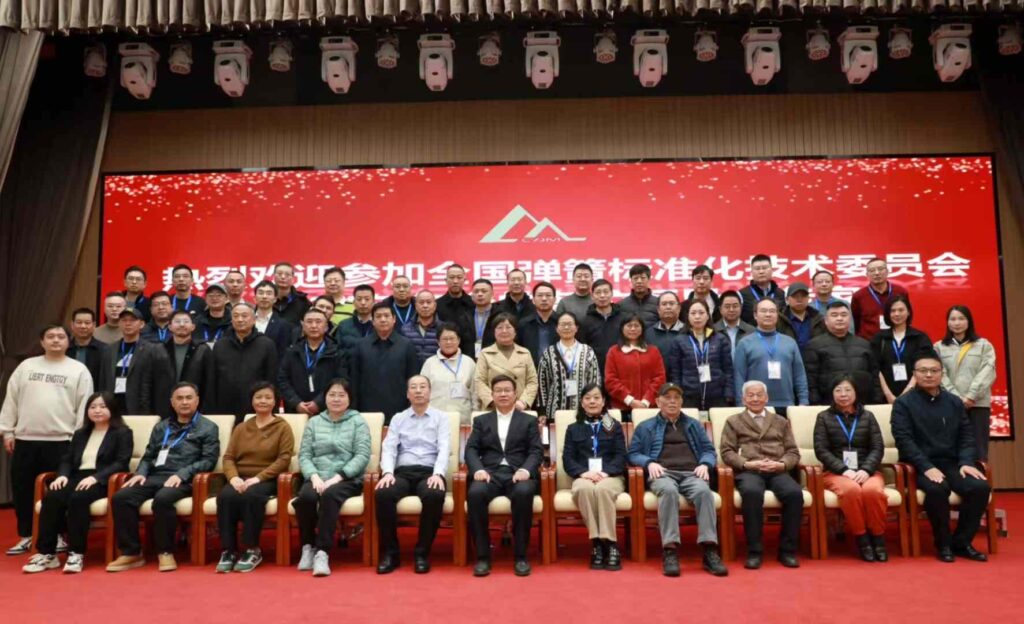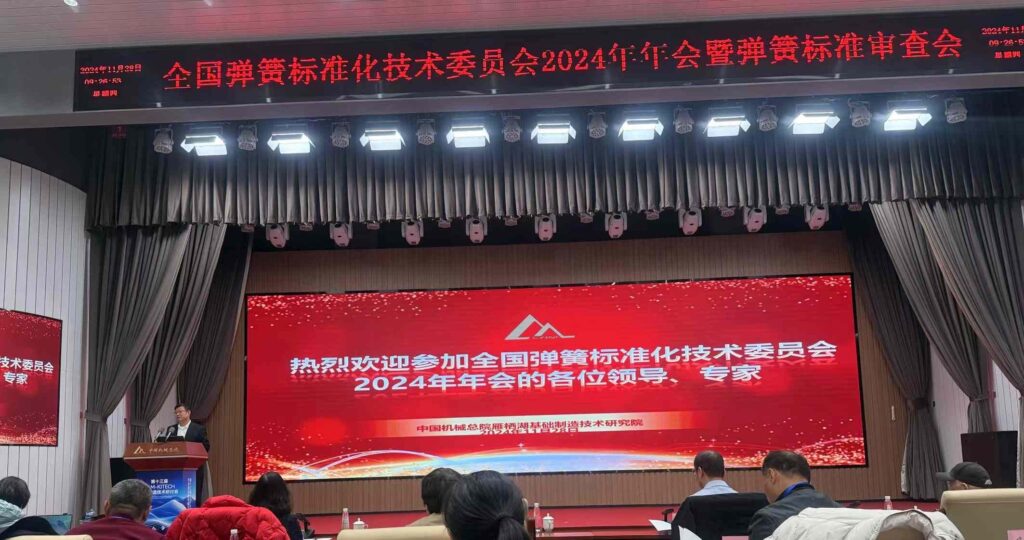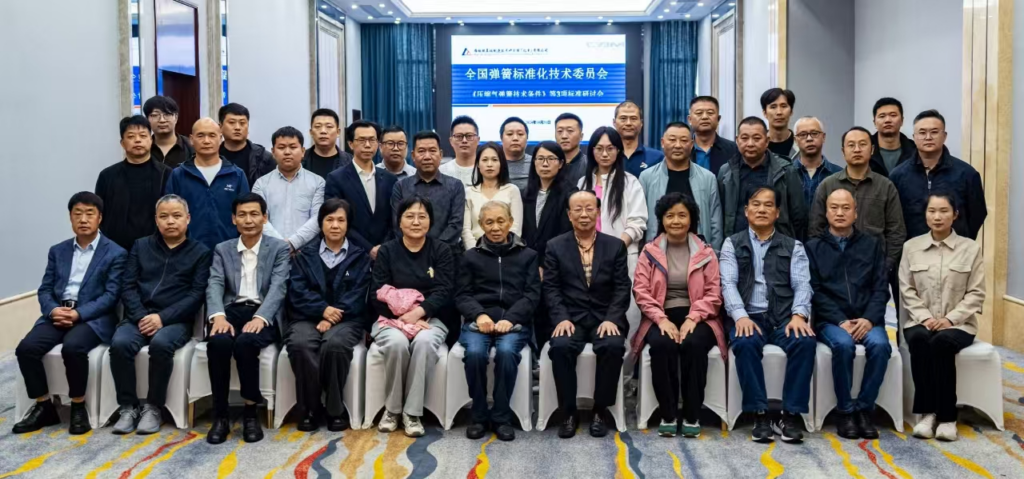Tag: National Standard Setter of gas spring in China
common structure types of gas spring
5 Common structure types
5.1 Structure type of commonly used compression gas spring (YQ) series
See Figure 1 for structure type of commonly used compression gas spring (YQ) series.
| Key 1 piston rod2 guide3 seal4 piston | 5 cylinder6 gas chamber7 oil8 spacer |
Figure 1 Schematic diagram of commonly used compression gas spring
5.2 Structure type of commonly used lockable gas spring (KQ)
5.2.1 Structure type of rigid lockable gas spring in the extension direction
See Figure 2 for Structure type used in rigid lockable gas spring in the extension direction.
| Key1 piston rod module2 guide3 seal4 oil | 5 piston module6 cylinder7 gas chamber | 8 separator piston module9 valve pin10 spacer |
Figure 2 Schematic diagram of rigid lockable gas spring in the extension direction
5.2.2 Structure type of rigid lockable gas spring in the compression direction
See Figure 3 for the Structure types of rigid lockable gas spring in the compression direction.
| Key1 piston rod module2 guide3 seal | 4 oil5 piston module6 cylinder | 7 valve pin8 separator piston module9 gas chamber |
Figure 3 Schematic diagram of rigid lockable gas spring in the compression direction
5.2.3 Structure type of elastic lockable gas spring
See Figure 4 for the Structure type of elastic lockable gas spring.
| Key1 piston rod module2 guide3 seal4 oil5 piston module | 6 cylinder7 gas chamber8 valve pin9 spacer |
Figure 4 Schematic diagram of elastic lockable gas spring
5.3 Structure type of commonly used chair height adjustment gas spring (ZSQ)
5.3.1 Structure type of elastic lockable chair height adjustment gas spring
See Figure 5 for the Structure type of elastic lockable chair height adjustment gas spring
| Key1 starting lever2 starting lever retainer3 valve4 valve pin5 guide of standing tube6 gas chamber7 standing tube | 8 cylinder (inner cylinder)9 piston rod10 outer tube11 inner cylinder retainer12 seal13 guide |
Figure 5 Schematic diagram of an elastic lockable chair height adjustment gas spring
5.3.2 Structure type of rigid lockable chair height adjustment gas spring
See Figure 6 for the Structure type of rigid lockable chair height adjustment gas spring
| Key1 starting lever2 starter lever retainer3 valve4 valve pin5 guide of standing tube6 oil chamber7 standing tube8 separator piston module | 9 cylinder (inner cylinder)10 piston rod11 outer tube12 gas chamber13 ventilation support14 seal15 guide |
Figure 6 Schematic diagram of rigid lockable chair height adjustment gas spring
5.4 Structure type of commonly used stretching gas spring
5.4.1 Structure type of ordinary stretching gas spring (LQ)
See Figure 7 for the Structure type of ordinary stretching gas spring (LQ)
| Key1 piston rod2 guide3 seal | 4 gas chamber5 cylinder6 piston module |
Figure 7 Schematic diagram of an ordinary stretching gas spring
5.4.2 Structure type of lockable stretching gas spring (KLQ)
See Figure 8 for the Structure type of lockable stretching gas spring (KLQ)
| Key1 guide2 seal3 spacer4 piston rod module5 gas chamber | 6 piston module7 guide seal of joint rod8 differential pressure joint rod9 cylinder |
Figure 8 Schematic diagram of lockable stretching gas spring
Gas spring design calculation (English version of national strandard, initiated by LeiYan Gas Springs), proposed and prepared by SAC/TC 235 (National Technical Committee 235 on Spring of Standardization Administration of China).
Gas spring design calculation
Foreword
SAC/TC 235 is in charge of this English translation, in case of any doubt about the contents of English translation, the Chinese original shall be considered authoritative.
This document is drafted in accordance with the rules given in the GB/T 1.1—2009 Directives for standardization— Part 1: Structure and drafting of standards.
This document was proposed and prepared by SAC/TC 235 (National Technical Committee 235 on Spring of Standardization Administration of China).
Gas spring design calculation (English version of national strandard, initiated by LeiYan Gas Springs)
1 Scope
This document specifies parameter names, symbols, descriptions and units of gas spring, as well as commonly used structure types, design calculation principles and design calculations.
This document is applicable to compression gas spring, lockable gas spring, chair height adjustment gas spring and stretching gas spring. Other gas springs may also be used in accordance with this standard.
2 Normative references
The following referenced documents are indispensable for the application of this document. For dated references, only the edition cited applies. For undated references, the latest edition of the referenced document (including any amendments) applies.
GB/T 2348, Fluid Transmission System and Component, Diameter of Cylinder and Piston Rod
3 Terms and definitions
For the purposes of this document,the following terms and definitions apply.
3.1
Gas spring
An elastic device consisting of an enclosed cylinder and a sliding piston and piston rod model with nitrogen or other inert gas used as the energy storage medium.
3.2
Compression gas spring
A gas spring in which the piston rod is in a freely extended state without external force and is subjected to pressure force.
3.3
Lockable gas spring
A gas spring that can be locked or unlocked at any position during the motion stroke.
3.4
Chair height adjustment gas spring
A gas spring used for chair height adjustment, which can be locked or unlocked at any position during the motion stroke.
3.5
Stretching gas spring
A gas spring in which the piston rod is free to resilience without external force and is subjected to tensile force.
4 Parameter names, symbols, descriptions and units
See Table 1 for gas spring parameter names, symbols, descriptions and units.
Table 1
| Parameter name | Symbol | Description | Unit |
| design stroke | S | Axial length of the piston rod from full extension (or tension) to full compression (or resilience) | mm |
| working stroke | S1 | The length between the maximum extension (or tension) and the minimum extension (or tension) of the gas spring in working condition | |
| safe stroke | S2 | Safe margin for the required working stroke: S2 = S – S1 | |
| extended length | L | Length of the gas spring at full extension (or tension)NOTE The extended length of the stretching gas spring is the length in the stretched condition. | |
| rod end length | L1 | Connection length of the gas spring rod end | |
| cylinder end length | L2 | Connection length of the gas spring cylinder end (chair height adjustment gas spring L2 = 0). | |
| gas chamber length | L3 | Gas chamber length of gas spring | |
| cylinder length | B | Cylinder length of gas spring | |
| guide length | H | Guide length of gas spring | |
| piston rod diameter | d | Piston rod diameter of gas spring | |
| inner diameter of hollow piston rod | d0 | Inner diameter of hollow piston rod of lockable gas spring | |
| valve pin diameter | d1 | Effective diameter of gas spring valve pin | |
| cylinder inner diameter | D1 | Inner diameter of gas spring cylinder | |
| cylinder outer diameter | D2 | Outer diameter of gas spring cylinder | |
| outer diameter of outer tube | D3 | Outer diameter of outer tube of chair height adjustment gas spring | |
| outer diameter of standing tube | D4 | Outer diameter of standing tube of chair height adjustment gas spring | |
| thickness of cylinder | δ1 | Thickness of gas spring cylinder: δ1 = (D2 – D1)/2 | |
| thickness of hollow piston rod | δ2 | Thickness of hollow piston rod of gas spring: δ2 = (d – d0)/2 | |
| thickness of outer tube | δ3 | Thickness of outer tube of chair height adjustment gas spring | |
| thickness of standing tube | δ4 | Thickness of standing tube of chair height adjustment gas spring | |
| center of gravity distance | l | Distance from the centre of gravity of the subject supported by gas spring to the centre of gyration | mm |
| arm of force | b | Arm of force of the gas spring when the lever arm is extended | |
| radius of gyration | K | Radius of gyration of the cross section of the gas spring piston rod | |
| cross section area | A | Cross section area of the gas spring piston rod | mm2 |
| moment of inertia | J | Moment of inertia of the cross section of the gas spring piston rod | mm4 |
| unlocking force | Fk | Force required to unlock the valve pin in order to unlock the gas spring | N |
| minimum extension force | F1 | During extension, the force at the specified measuring point C1 from the beginning of the working stroke | |
| maximum extension force | F2 | During extension, the force at the specified measuring point C1 from the end of the working stroke | |
| minimum compressive force | F3 | During compression, the force at the specified measuring point C1 from the beginning of the working stroke | |
| maximum compressive force | F4 | During compression, the force at the specified measuring point C1 from the end of the working stroke | |
| minimum tension force | F5 | During the tension process, the force at the specified measuring point C1 from the beginning of the working stroke |
| Parameter name | Symbol | Description | Unit |
| maximum tension force | F6 | During the tension process, the force at the specified measuring point C1 from the end of the working stroke | N |
| minimum resilience force | F7 | During the resilience process, the force at the specified measuring point C1 from the beginning of the working stroke | |
| maximum resilience force | F8 | During the resilience process, the force at the specified measuring point C1 from the end of the working stroke | |
| nominal force a | Fa | The average of the minimum extension force and the minimum compress force, i.e.: Fa = (F1 + F3)/2. Or the average of the minimum tension force and the minimum resilience force, i.e.: Fa = (F5 + F7)/2.The “nominal force a” is one of the indicators of the comprehensive characteristics of a gas spring | |
| nominal force b | Fb | The average of the maximum extension force and the maximum compress force, i.e.: Fb = (F2 + F4)/2. Or the average of the maximum tension force and the maximum resilience force, i.e.: Fb = (F6 + F8)/2.The “nominal force b” is generally used in the calculation of the resilience force ratio | N |
| specified force | Fx | The forces (F1, F2, F3…) marked on the products and drawings agreed between supplier and vendor | |
| dynamic friction force | Fr | The average of the difference between the minimum compress force and the minimum extension force, or the average of the difference between the minimum tension force and the minimum resilience force | |
| valve pin friction | fr | Normally the friction generated by the valve pin is 10 to 30 | |
| gravity | G | Gravity of the object supported by the gas spring | N |
| permissible critical force | FL | Permissible critical force of the gas spring piston rod | |
| pressure | P | Pressure within the gas spring | MPa |
| maximum pressure | Pmax | Maximum pressure within the gas spring in working condition | |
| modulus of elasticity | E | Modulus of elasticity of the material, for steel using 2.1 x 105 | |
| allowable stress | [σ] | Allowable stress of material | |
| test value of material strength | f | Test value of material strength, for steel using 490 | |
| force ratio | α | Ratio of nominal force b to nominal force a, i.e., α = Fb/Fa | —— |
| radius ratio | r | Ratio of cylinder outer diameter to inner diameter | |
| safety factor | n | Safety factor for piston rod stability, which is generally n ≥ 1.4 | |
| installation coefficient | m | Installation coefficient of gas spring | |
| temperature coefficient | o | Compensation coefficient for demanded force affected by temperature changes of the gas spring working environment , which is generally 1.1 to 1.25 | |
| number | i | Number of gas springs | |
| measuring point | C1 | The measuring point of the force during dynamic or static measurement, which is generally S ≤ 80 mm, C1 = 5 mm; S > 80 mm, C1 = 10 mm | mm |
Table 1 (continued)
The English Version of the National Standard “Gas Spring Design Calculation” Passed Evaluation
On November 28, 2024, a significant event in the field of mechanical industry standards – the 2024 Annual Meeting of the National Technical Committee for Spring Standardization and the Spring Standard Review Meeting – grandly opened at the Yanxi Lake Institute of Basic Manufacturing Technology of China Academy of Machinery Science, nestled amidst beautiful scenery. This conference not only carried the industry’s deep – seated expectations for standardized development but also gathered numerous authoritative experts and enterprise elites, who jointly contributed ideas and strategies to the standardization process of the spring industry.
The atmosphere at the conference venue was both enthusiastic and solemn. Participants engaged in in – depth discussions and rigorous reviews of a number of key national standards. These standards covered multiple crucial areas of the spring industry, playing a pivotal role in standardizing industry production, enhancing product quality, and promoting technological innovation.
Among the many highly – anticipated standard reviews, the review of the English version of the national standard “Gas Spring Design Calculation” attracted particular attention. A rigorous and professional review team was formed, consisting of industry veterans such as those from China Productivity Center for Machinery, Yu Fang, Jiang Ying, and Cai Linxu from the Secretariat of the National Technical Committee for Spring Standardization, Ning Cheng from LeiYan Gas Springs, and Ning Yan from Beijing Leiyan Nitrogen Gas Spring Technology Research Institute, and Wang Haiyang from Jiangsu SanJo Intelligent Technology Co., Ltd. Equipped with profound professional knowledge and rich practical experience, they conducted multiple rounds of meticulous reviews of the English – language submission draft for approval of “Gas Spring Design Calculation”. From the precise translation of professional terms to the accurate interpretation of technical clauses, every detail was carefully deliberated and considered.


Meanwhile, the members of the translation working group also made unremitting efforts. They worked day and night, surmounting numerous difficulties in the language – conversion process, striving to express every professional concept and technical requirement in the standard most accurately and clearly in English. During the long translation process, they constantly consulted materials and sought advice from experts, aiming to ensure that the translation quality reached an international – class standard.
Through the joint efforts of the review team and the translation working group, the English – language submission draft for approval of “Gas Spring Design Calculation” successfully passed at this annual meeting. This achievement is of great significance. It marks that the standards in the field of gas spring design and calculation in China will officially step onto the international stage, building a solid bridge for global technical exchanges and cooperation in the gas spring industry. In the future, domestic and foreign enterprises and scientific research institutions will have a unified standard reference in gas spring design and calculation. Undoubtedly, this will greatly promote the sharing and innovation of relevant technologies, propelling the entire industry to advance in a more standardized and internationalized direction.
The Review Meeting of the English Version of the National Standard “Gas Spring Design Calculation” Was Successfully Held
On November 19, 2024, the National Technical Committee for Spring Standardization organized and held a review meeting for the English version of the submission draft of GB/T 39433 “Gas Spring Design Calculation” (hereinafter referred to as the “submission draft of the standard”) on Tencent Meeting for technical review. A total of 16 industry experts and members of the Spring Standardization Committee, including Yu Fang, Jiang Ying, and Cai Linxu from the Secretariat of the National Technical Committee for Spring Standardization and China Productivity Center for Machinery, Ning Cheng from LeiYan Gas Springs, and Ning Yan from Beijing Leiyan Nitrogen Gas Spring Technology Research Institute, and Wang Haiyang from Jiangsu Sanqiao Intelligent Technology Co., Ltd., participated in this meeting.


First of all, the standard drafting working group reported on the task source of the standard, translation instructions, solicitation of opinions, and handling of opinions.
The participating committee members and representatives carefully and meticulously reviewed the submission draft of the standard clause by clause and sentence by sentence, and formed the following review opinions:
- The review materials of the English version of GB/T 39433 “Gas Spring Design Calculation” provided by the working group are complete, and the structure is standardized, which meets the review requirements for the English version of national standards.
- The English translation of the content of the submission draft of the standard is accurate.
- This standard will promote international exchanges and cooperation in the development of related gas spring technologies.
- After full deliberation, the expert group put forward modification suggestions for some provisions.
The participating experts unanimously agreed to pass the review of the English translation submission draft of GB/T 39433 “Gas Spring Design Calculation”, and requested the drafting working group to revise and improve it according to the opinions put forward by the experts at this meeting, so as to form the final submission draft of the English version of the national standard.
Seminar on 4 Gas Spring Standards Successfully Held in Liyang
On October 31, 2024, the seminar on 4 standards including “Technical Conditions for Compression Gas Springs”, which was sponsored by the National Spring Standardization Technical Committee and undertaken by LeiYan Gas Springs, was grandly held in Liyang, Jiangsu. This seminar brought together many authoritative units and experts in the industry to jointly contribute ideas for the improvement and development of the gas spring industry standards.
The representatives from China Productivity Center for Machinery, as well as professionals such as Yu Fang, Jiang Ying, and Cai Linxu from the Secretariat of the National Spring Standardization Technical Committee, attended the meeting. Ning Cheng from LeiYan Gas Springs, Ning Yan from Beijing Leiyan Nitrogen Gas Spring Technology Research Institute, Wang Haiyang from Jiangsu Sanqiao Intelligent Technology Co., Ltd., and representatives from the German enterprise SUSPA also participated in this grand event.

During the meeting, all parties involved carried out in – depth discussions on the review work of the 4 standards. From the analysis of the current situation of the planned projects, to the comparative research of domestic and international standards, and then to the specific revision suggestions, every link was comprehensively and meticulously exchanged. After full discussion, the meeting formed clear resolutions and matters to be done, pointing out the direction for the follow – up work.
All participating units and experts stated that they would actively carry out relevant work in strict accordance with the requirements of the meeting resolutions. Through joint efforts, they will promote the continuous improvement of gas spring industry standards, enhance the overall development level of the industry, and provide more standardized and high – quality products and services for the market.
The successful holding of this seminar on 4 standards including “Technical Conditions for Compression Gas Springs” has injected new impetus into the standardization process of the gas spring industry, marking a solid step forward for the industry on the path of standardization and specialization. It is of great significance for promoting the healthy development of the gas spring industry. It is believed that with the joint efforts of all parties, the gas spring industry will embrace an even more brilliant future.
